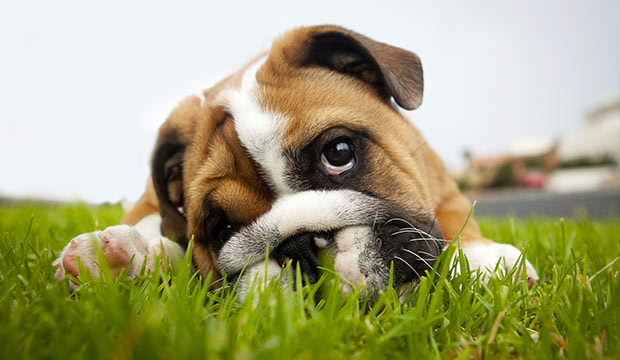
Though dogs truly are our best friends, they can sometimes be, well, a bit weird about things. Let’s face it—our partnership with them has only lasted for twenty thousand years or so. Before that, they’d had millions of years of experience under their belts.
Let’s take a look at some of our canine companions’ strangest behaviours, and then try to understand them from a dog’s perspective. Most often, there’s a good reason for an odd behaviour if you just look closely enough!
15. Coprophagy
Several reasons exist for a dog eating what would seem to be such a poor food source. If you have ever raised a litter of puppies, you’ll know that their mother will normally clean up after them by eating their faeces.
This is not only a sanitary solution, but an age-old survival mechanism.
In the wild, predators hungry for a bit of puppy could locate the den simply by the scent of faeces. It became necessary, then, for the mother to get rid of this evidence.
Another cause of coprophagy is poor diet. If a puppy or adult dog is eating a nutritionally deficient diet or is not being fed enough, it will instinctively seek out another food source. This often means feces in the yard or dog park.
To prevent coprophagy, keep your dog’s environment perfectly free of any waste. Pick it up right away! Try not to leave a dog with this habit alone in a yard or dog run for any length of time, as he will eat the waste and self-reinforce the behaviour.
Be sure to feed the best food possible, in amounts suitable for your dog. If in doubt, consult your veterinarian on this.
14. Humping
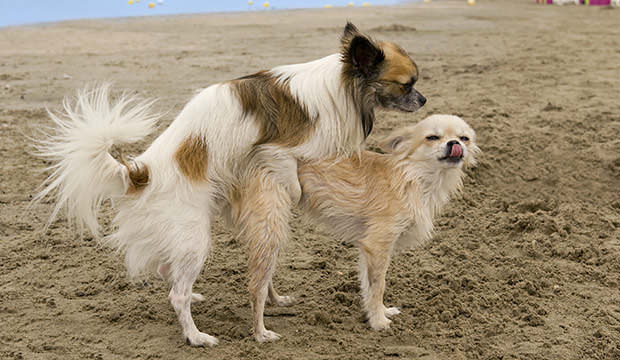
Even more awkward is when it happens to human guests in your home. Why is this happening?
Though humping is a sign of sexual excitement and is often paired with signs of physical arousal and a desire to mate, it’s not that simple. The motivations for humping/mounting are varied.
Though unneutered males are the most likely culprits, any dog—male, female, young or old—can develop a humping habit. Often evolving out of play, puppies will often hump each other, as will older dogs.
The anxious, isolated dog can evoke this behaviour as a stress release mechanism. Status confusion among a group of dogs and/or humans can result in a dog humping sequential “victims,” in an attempt to clarify his/her standing.
Solutions to humping are comprehensive. First, make sure your dog is getting enough stimulation. Exercise, play, socialization, training, and routine are all vital. Obedience train, as it teaches your dog to think, calms him, and gives you a way to control and refocus.
For instance, instead of letting two dogs hump each other all over the yard, put them both through some obedience exercises such as down/stays, paired walking, or recalls.
13. Reverse Sneezing
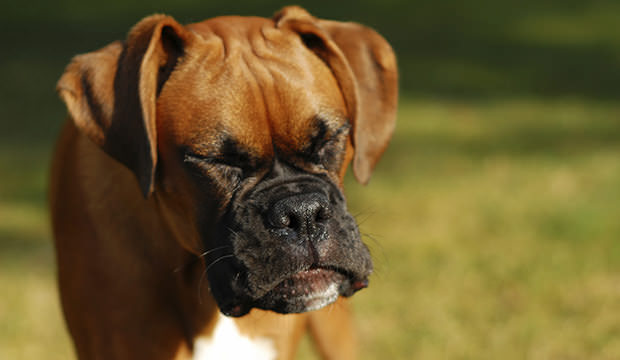
After a few moments, the event is over, and he seems fine. This is the “reverse sneeze,” one of a dog’s most bizarre behaviours.
Technically known as “paroxysmal respiration,” reverse sneezing sounds awful but really isn’t. Reverse sneezing can be caused by an irritant in the air, by eating or drinking too fast, by a foreign body or hair balls, or even a nasal infection.
The resultant irritation of the palate or throat causes a spasm, resulting in quick inhalations of air into the dog’s nose. The trachea can narrow, causing difficulty in air movement. The condition is more common in older dogs.
To reduce the chances of reverse sneezes, minimize chemicals, cleaners, rug deodorizers or other potential irritants from the home. Groom your dog often, and vacuum up hair every day. If a nasal drip is present, see the veterinarian.
12. Tail Chasing
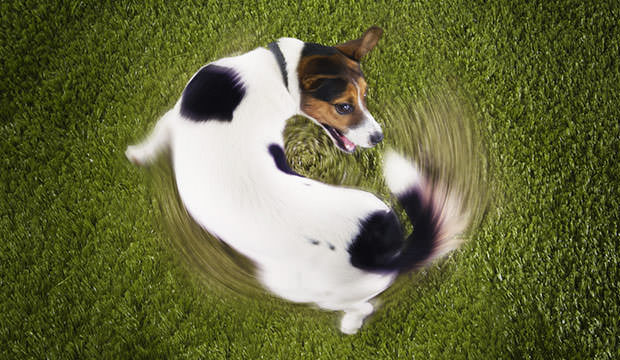
We suppose if we had long, fluffy tails and could chew on them, we might even give it a try.
It’s a behaviour that often starts early on; a puppy, barely aware of his own individuality, sees the tail and begins to whirl around after it.
It’s fun, and serves some deep-seated need to chase something. Of course when humans see this, they laugh, and often encourage the dog on. And so the behaviour slowly becomes engrained.
Other dogs go for their tails because of a flea, tick or worm problem; they try to chew on it to relieve the itch. Dermatitis or dirt can also initiate the need to bite the tail. Still other dogs begin the behaviour out of boredom, or because of underlying stress.
Tail chasers often slip into an obsessive-compulsive mode. Some will literally spin and spin until dizzy, or until their nails or pads wear down from the constant friction.
To prevent obsessive tail chasing, be sure to keep your dog as pest-free and clean as possible, thus preventing tail biting spurred from infestation or dirt. Remove tangles from his tail fur, use a flea/tick preventive prescribed by a veterinarian, and get dermatitis diagnosed and treated.
11. Rolling In Stinky Stuff
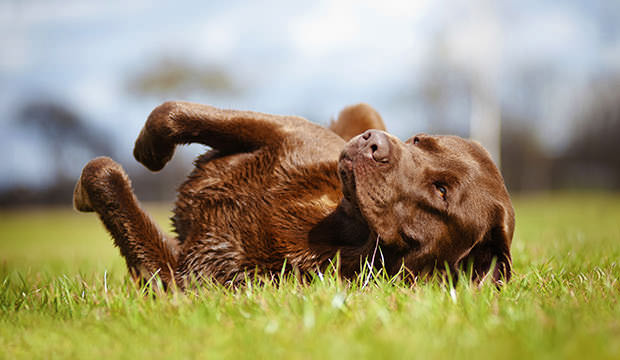
Like it or not, some do, and seem to get great pleasure out of it. And it’s rarely the dog’s own mess; rather, it’s nearly always something else’s putrid leavings. Go figure.
Why? One theory claims that dogs want to mark over a strong scent with their own smell, rising to the olfactory “challenge.” Others posit it’s a holdover from when dogs wished to camouflage their own scent in order to sneak up on prey.
Or it may simply be that dogs to whom scent is everything, simply revel in the fragrances emitted by gross things. To dogs, what we find horrid is actually interesting. Think teenage boys wearing cheap cologne.
To prevent your dog anointing himself with eau de rotting seal keep things as clean as possible around home and property. While on walks, make sure you decide when your dog stops to relieve himself, or investigate. Keep an eye out for garbage, dead animals, or generally stinky stuff.
Work on the Leave it! command, as well as a reliable recall command to stop an off-leash dog from rolling in stink. If needed, use a loud clap and a verbal Leave it! if you see him going for that flattened squirrel. Otherwise, you’ll be spending a lot on dog shampoo.
10. Howling
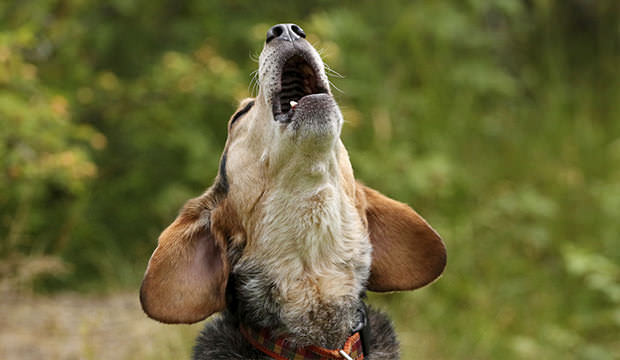
It could just be a behaviour passed on from their ancestral cousins, but behaviourists also think that howling is instinctively necessary and rewarding for dogs.
If your neighbours call you and tell you that your dog is howling when you are at work, your dog’s excessive howling might be caused by separation anxiety. Separation anxiety howling only occurs when a dog is left alone or otherwise separated from his owner.
This kind of howling is usually accompanied by at least one other symptom of separation anxiety, such as pacing, destruction, elimination, depression or other signs of distress.
Some newly adopted dogs may vocalize at first when they are left alone, as they are getting used to their new home. Even dogs you’ve had for a while can be upset by changes in their routine, such as your work hours changing, a new roommate, etc.
Put them on a very consistent, reliable routine and giving them time to adjust – at least one week of the same schedule (of eating, playing, & exercise) every day. That includes weekend days! Even if your hour-by-hour schedule varies day to day, make sure your dog’s stays exactly the same.
9. Circling Before Lying Down
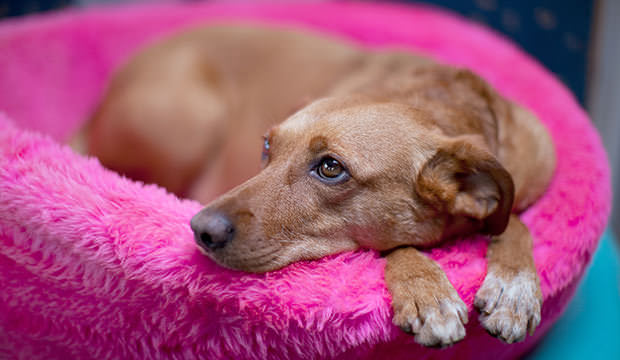
You can blame your dog’s ancestors for this curious ritual.
Behaviourists believe that when wolf-like dogs lived in the wild, they would walk around a spot to pat down the leaves, grass or other debris to create a nice nesting spot.
Restlessness can be a sign of discomfort or even pain. If your dog is repeatedly circling and digging but can’t seem to get comfortable, he may have a health problem, such as arthritis or neurological problems.
You should observe your pet to see if he’s having trouble getting up and settling down. If he’s restless, take him to the vet to rule out pain and get a proper diagnosis.
8. Begging At The Table
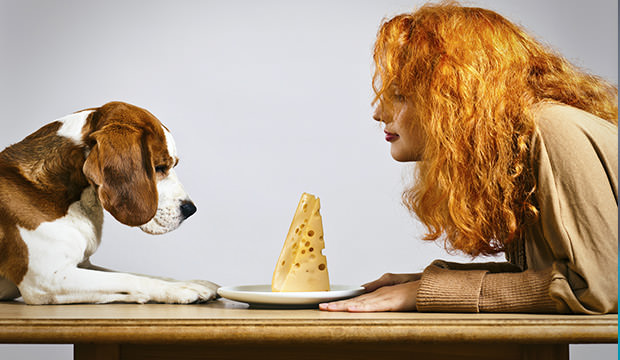
Why do they do it? Because it works! If a dog begs, and you give them one single morsel, they will continue to beg. If you never give them snacks, and your guests don’t either, the begging will stop.
Sometimes it’s easiest to solve a problem by preventing it from happening. If you’d rather your dog leave you alone while you eat, you can use a baby gate to confine him to another room when you sit down for a meal. Or, if your dog is crate trained, you can put him in his crate while you eat.
If your pup’s already developed the bad habit, try giving your dog something else to do, like chew on a stuffed and frozen Kong toy in their crate or on their bed during dinner time.
7. Destroying His Toys
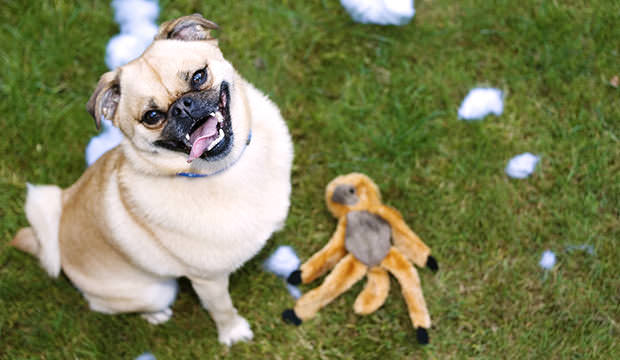
Aside from the dog’s perspective of toy equals fun, they can provide oral activity for the mouthy adolescent, relieve boredom, be a reward for good deeds, provide activity and exercise, and make you more relevant.
But why do some dogs tend to destroy their toys? Our theory goes back to nature. When dogs hunted for prey, they would hunt and kill. Their prey would squeak or make noises.
This was part of their natural hunting instinct. Once caught, the prey made noises as the dog proceeded with the kill, which can be very satisfying to a hungry dog. When the prey was dead – the squeaking stopped.
If your dog is always playing with the ten toys you bought him, then he’ll get tired of them and unimpressed when you leave. Make sure you hide all of his toys in a closet and only allow two or three to be out at a time.
When you switch the toys around, your dog will be entertained more and he’ll think it’s a treat when he gets an old toy to play with that’s been hidden away. As an added incentive, this will prevent you from spending more money on new toys whenever you’re planning on leaving for a long period of time!
6. Staring
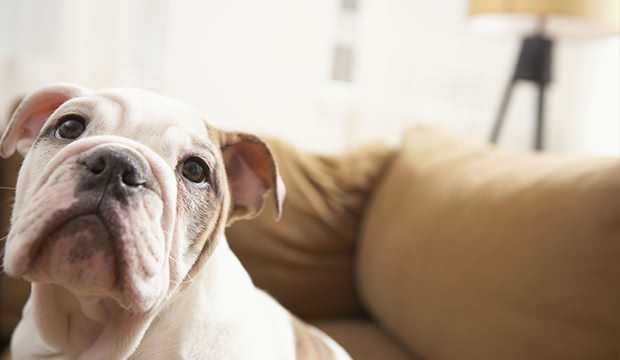
But some dogs take staring to extremes, following their owners around with baleful eyes as if expecting links of sausage to fly from their human’s fingertips.
Let’s face it: Dogs love their owners, but when they stare expectantly, it’s not usually because they’re trapped in a reverie of devotion. Rather, it’s because they’re thinking they might get something. And usually, that “something” involves a tasty snack.
But dogs can—and do—stare at their owners for plenty of non-food issues, too. Indeed, anything a dog might want that a human can provide could be the source of the staring behavior, from a fun game of fetch to a ride in the car or a long run.
Then there’s the possibility that a dog is simply seeking attention in any form, or perhaps she’s merely waiting for praise or direction. Some dogs may just be trying to read an emotion in our human facial expressions.
In any case, staring is typically considered to be a good thing. In fact, most trainers encourage dogs to stare at their owners while awaiting their cues. And if you’ve never done it, gazing deeply into a dog’s eyes can be a highly rewarding pastime.
Before you try it, be aware that staring directly into a dog’s eyes can be considered a direct challenge. That’s why mutual staring is an activity that’s only to be encouraged within the context of a healthy dog-human relationship unsullied by any taint of aggression or behavioural abnormalities.
5. Obsessive Licking
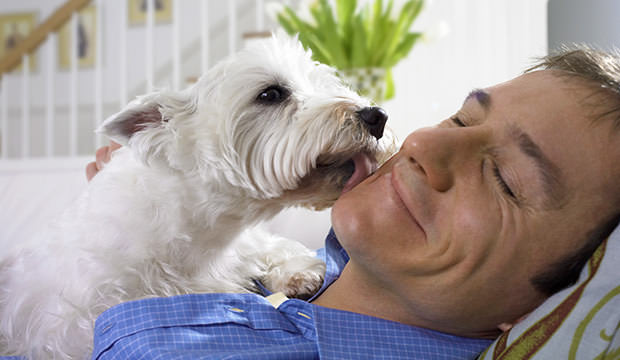
This licking may occur often, but because it seems harmless and may only be somewhat annoying, many owners accept this unusual behavior or simply ignore it.
However, some owners will inquire about it during a routine check-up and ask for advice.
Such owners often describe a dog that licks floors, carpets, walls, furniture, its own lips, and even the owner’s legs, hands, or arms constantly. When not a result of an underlying medical problem, the behavior is unlikely to cause harm.
However, if hair and fibres are ingested, constant licking can potentially result in life-threatening intestinal blockage that requires surgical intervention.
Many dogs that begin licking surfaces for any reason learn that performing the behavior results in a response from the owner. Even if that response is punishment, it may be rewarding to a dog that desires attention.
Once dogs learn that a certain behavior results in attention, they are likely to repeat the behavior. Whatever the case may be, make sure you check with your local vet if this behaviour is just playing silly or a real medical issue.
4. Sleep Running
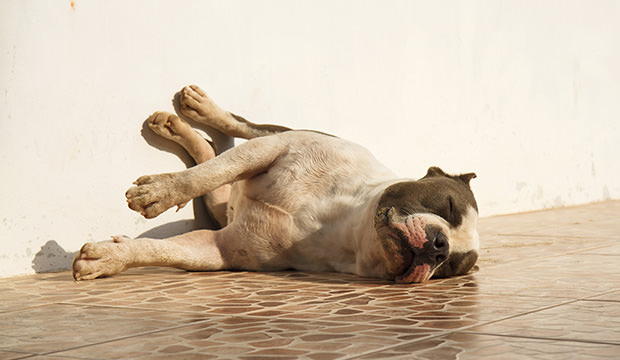
The only difference is that large muscle movement, in the legs, for example, is inhibited.
In what’s called R.E.M sleep disorder, the brain signals reach the large muscles so that the animal acts out its dreams.
A small amount of twitching is normal when a dog sleeps, but continued muscle spasms might not be. Even the largest dogs only dream for a few minutes at a time, so watch the clock if you’re concerned about your dog’s movements.
If they continue for more than five minutes or if you notice similar twitches when your dog is awake, it’s time to contact your vet. Involuntary muscle movements might signal a medical condition that requires immediate treatment, such as a neurological disorder, organ failure, toxin ingestion or a reaction to medication.
3. Fear Of Thunder
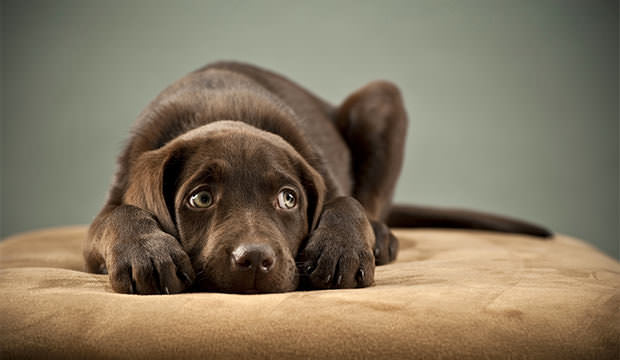
Symptoms of a phobia include pacing, shivering, and drooling. Some dogs panic and try to escape, and there have been cases of dogs injuring themselves by slamming into doors or glass panes.
If your pup starts acting like he’s seen a poltergeist whenever there’s a storm, intervention may be in order. Try playing a CD of a thunderstorm at a low volume while playing with him and giving him treats.
Raise the volume on CD slowly, and only when he is comfortable – or the therapy may backfire. The idea is to get him to associate thunder with good times.
2. Fireworks Phobia
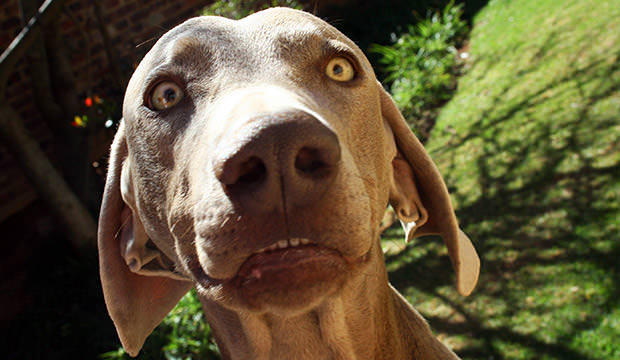
Even a seemingly confident dog can tremble and drool at the unfamiliar sounds.
If your dog destroys the house every 4th of July, he may be afraid of the fireworks in the neighbourhood. Don’t add to his anxiety by yelling or punishing him.
Again, pick up a sound effects CD and play the sound of fireworks at low volume. Play with him and give him treats as you do. Gradually increase the volume so that he associates the loud noise with fun.
This will work for some dogs, while others will need medication. In the case of a severe phobia, nothing may work to ease your dog’s fear. If there’s a chance your dog make exhibit this level of fear, talk to your veterinarian about medication.
He may be able to prescribe an anti-anxiety medication or sedative to keep your dog calm during the fireworks.
1. Hate Or Disliking Towards Other Dogs
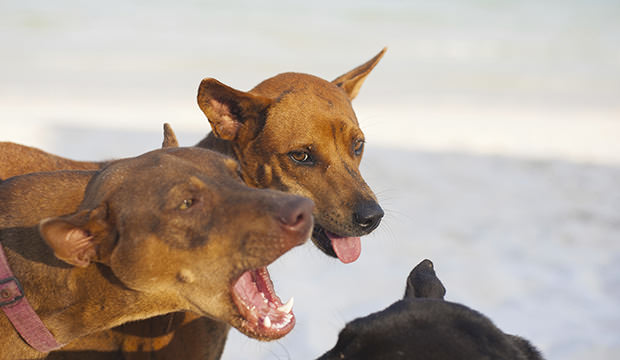
Your dog might have had unpleasant encounters with other dogs in the past, he may have been insufficiently socialized as a puppy, he might have been badly trained or he might just not like other dogs for no apparent reason.
If your dog is the canine equivalent of a human misanthrope, it should be possible to change this, at least to passable politeness.
Determine when your dog shows dislike of other dogs, whether aggression or fear. Is it when he is on the leash and passes another dog, or under all circumstances? Also find out how close does the other dog need to be before your dog starts showing his dislike.
Get your dog used to wearing a head halter in an unthreatening, peaceful environment, such as your living room. Adjust it so it fits and put it on him for gradually increasing lengths of time, using small treats to encourage him into it and to reward him once it is on.
Once he is as comfortable with the head halter as he is with his normal collar or harness, you can begin using it outside for increasingly long periods. Using a head halter simply means that you have more control over your dog and can move him quickly away from a passing canine, and stop him glaring menacingly.
This is a humane method of restraint, provided you don’t pull hard.
